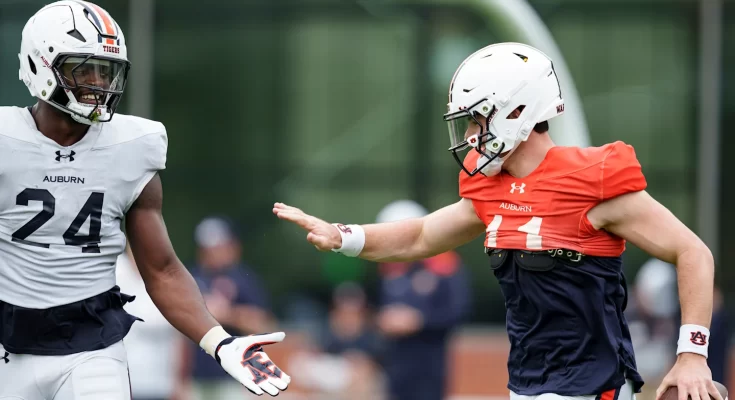3 Bold Predictions for Auburn Tigers’ Offense in 2025
As the Auburn Tigers enter the 2025 college football season, there’s cautious optimism around Hugh Freeze’s ability to revitalize an offense that has seen its share of inconsistencies in recent years. Since his arrival on the Plains, Freeze has worked to reshape Auburn’s offensive identity, hoping to reestablish the Tigers as one of the SEC’s more dynamic units. While 2024 was a year of transition, 2025 could be the breakthrough. The Tigers return key players at skill positions, have brought in fresh talent via both recruiting and the transfer portal, and now boast improved cohesion along the offensive line. Though SEC defenses remain among the nation’s most daunting, there are reasons to believe Auburn’s offense can surprise opponents and fans alike. With that in mind, here are three bold predictions for Auburn’s offensive unit in 2025.
First, the most daring assertion: Auburn will average over 35 points per game this season. In the past five years, the Tigers have struggled to consistently light up the scoreboard, often falling victim to poor quarterback play, a lack of vertical threats, and inconsistent line performance. The 2024 campaign was emblematic of this, as the Tigers hovered around the middle of the pack in the SEC in points per game. But 2025 presents a confluence of factors that suggest a breakout is coming. The maturation of quarterback Hank Brown, who flashed impressive decision-making and arm strength in limited action last season, is critical. While Freeze initially leaned on veteran signal callers, Brown’s late emergence in 2024 hinted at a new offensive direction. Now entering the year as the presumed starter, he brings confidence and command that was missing in previous iterations of the Tigers’ offense.
Brown will have the benefit of throwing to a much-improved receiving corps. Auburn’s wide receiver room has been rebuilt with a blend of returning talent and transfer additions. Sophomore breakout sensation Cam Coleman, a former five-star recruit, is expected to become the Tigers’ first true WR1 in years. His ability to stretch the field vertically will demand attention from opposing secondaries, which should open up underneath routes for savvy slot receivers like Jay Fair and freshman dynamo Malcolm Simmons. Coleman’s presence alone elevates Auburn’s passing potential, but it’s the scheme adaptation by Freeze and offensive coordinator Philip Montgomery that gives this prediction legs. Expect Auburn to push tempo more frequently, lean into RPO looks that allow Brown to make quick decisions, and use the entire field to exploit mismatches. With better spacing and talent, Auburn is in position to score at a rate not seen since the peak Gus Malzahn years.
Complementing the aerial attack is an offensive line that finally appears SEC-ready. This group has been an Achilles’ heel for nearly half a decade, but offseason development and portal reinforcements have turned it into a potential strength. Anchored by senior leader and left tackle Dillon Wade, the line now features depth and versatility. The addition of a top JUCO guard and the emergence of second-year center Connor Lew provide stability across the interior. This will be crucial in both pass protection and run-blocking execution. The run game, after all, remains a bedrock of Freeze’s philosophy. Auburn’s rushing attack, which ranked in the middle of the conference last year, will get a major boost from sophomore star Jeremiah Cobb. He has the potential to eclipse 1,000 yards with his mix of vision, acceleration, and durability. Paired with Cobb will be Damari Alston and redshirt freshman J’Marion Burnette, creating a three-headed monster that can wear down defenses in the second half. With all these factors aligned, 35 points per game is not only bold—it’s within reach.
Second, Auburn will produce two 1,000-yard skill players for the first time since 2013. That year, Nick Marshall and Tre Mason were the heart of a national title-contending offense. Since then, the Tigers have had flashes of individual brilliance, but rarely sustained production from multiple sources. In 2025, that drought ends. All signs point to Cam Coleman surpassing 1,000 yards receiving if he stays healthy. His combination of size, speed, and route-running has drawn comparisons to elite SEC wideouts, and with a full season of starts, he will see high volume and red-zone opportunities. Coleman’s chemistry with Brown is already ahead of schedule, and Freeze’s offense will be built to highlight his talents.
The second 1,000-yard player will come from the backfield, with Cobb as the prime candidate. His 2024 campaign saw him rack up over 800 yards despite splitting carries, and the offensive staff has made it clear he will be the featured back in 2025. Cobb’s ability to break tackles and maintain top-end speed through contact makes him the ideal lead runner in Freeze’s zone-heavy ground game. Importantly, Cobb also contributes as a receiver, giving him multiple avenues to accumulate yardage. Assuming Auburn plays in at least 12 games, including a potential bowl appearance, Cobb needs to average just over 83 yards per game to reach the milestone. With Auburn’s improved blocking and renewed offensive tempo, that benchmark is realistic.
What makes this prediction particularly bold is the SEC’s defensive pedigree. Producing even one 1,000-yard player is an achievement in this league, given the weekly grind and the strength of opposing fronts. Doing so with two players in the same offense requires a sustained level of execution and health. But Freeze’s track record suggests he knows how to build explosive units. During his tenure at Ole Miss, he produced multiple 1,000-yard receivers and saw his backs average high per-carry outputs. Auburn now has similar pieces to replicate that success. Moreover, the Tigers’ schedule includes several non-conference games that should allow their stars to accumulate early stats, building momentum for tougher SEC contests.
Finally, the boldest and perhaps most controversial prediction: Auburn will finish the season with a top-five offense in the SEC. This statement demands scrutiny, especially considering the firepower present elsewhere in the league. Georgia, Alabama, LSU, and Texas are perennial contenders with deep rosters and potent schemes. Tennessee and Ole Miss have become synonymous with offensive fireworks. For Auburn to leap into that upper tier, they will need to be efficient, aggressive, and consistent—traits that have eluded the program in recent years.
Yet the ingredients are in place. The quarterback room, long a question mark, now has both a capable starter in Hank Brown and depth behind him with Walker White pushing for reps. The skill talent, from Coleman and Cobb to a quietly talented tight end unit led by Rivaldo Fairweather, can match up well with SEC defenses. The scheme is no longer in flux—Freeze has his system fully implemented and tailored to the personnel he recruited. The offensive line has both experience and athleticism, allowing the Tigers to control the line of scrimmage better than in years past.
What gives this prediction added weight is the context of the 2025 schedule. Auburn avoids some of the most brutal defensive matchups from the East division, and they host several key games at Jordan-Hare Stadium, where Freeze’s teams tend to play with added confidence. If Auburn can pull off a couple of early wins and build offensive rhythm, the momentum could carry them through the meat of the schedule. Scoring consistently against SEC defenses still requires discipline and execution, but with improved quarterback play, a bell-cow running back, and a legitimate receiving threat, Auburn now has a diversified offense that doesn’t rely on just one phase to win.
Statistically, a top-five finish in the SEC means averaging somewhere north of 425 total yards per game and scoring in the mid-30s. It means staying ahead of chains, limiting turnovers, and converting red-zone trips into touchdowns. It also requires flexibility—being able to adapt when the run game is stymied or when trailing late in a contest. Freeze has shown he can design creative game plans, and with a full year under his belt at Auburn, this team is ready to execute at a higher level. If Auburn gets hot early, especially in matchups against defensive-light teams like Vanderbilt or Mississippi State, it could build the confidence needed for tougher battles down the stretch.
In closing, Auburn’s offense in 2025 isn’t just a work in progress—it’s a powder keg waiting to explode. After years of watching other SEC teams steal the spotlight with high-octane play, the Tigers finally have the roster, the leadership, and the vision to reenter the conversation as a top-tier unit. Bold predictions often hinge on the unexpected, but sometimes they’re just ahead of the curve. Scoring 35 points per game, producing two 1,000-yard stars, and finishing among the top five offenses in the SEC would mark a dramatic shift for a program long associated with defense-first football. Yet under Hugh Freeze’s guidance, the Auburn Tigers are poised to prove that explosive, balanced offense can thrive once again on the Plains. If the 2025 season unfolds as expected—or better—it won’t just be a bold prediction. It will be a statement of arrival.



